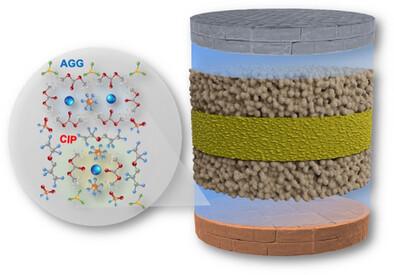优化无阳极石榴石基混合固态电池的锂成核过电位
IF 26
1区 材料科学
Q1 CHEMISTRY, PHYSICAL
引用次数: 0
摘要
无阳极固态锂电池有望实现高能量密度存储,但仍然受到固体电解质和原位形成的锂之间不稳定界面的限制。在这项工作中,使用局部高浓度电解质AlCl3和LiPO2F2,三层石榴石型Li6.4Ga0.1La2.9Ba0.1Zr1.6Ta0.4O12固体电解质,开发了一种混合固液电解质策略。这种结构形成了一种机械稳定的离子导电固液电解质界面,在2 mA cm - 2和1 mAh cm - 2的Cu/Li半电池中,经过300次循环后,库仑效率达到81%。单层无阳极混合固态袋状电池表现出优异的长期循环性能,在1C (1.25 mA cm - 2)下循环400次后仍保持75%的初始容量,无外部压力和室温下的库仑效率为99%。在实验室规模上,这种混合电解质方法显示出可扩展性和性能,为下一代无阳极混合固态锂电池提供了潜在的实用途径。本文章由计算机程序翻译,如有差异,请以英文原文为准。

Optimizing Lithium Nucleation Overpotential in Anode-Free Garnet-Based Hybrid Solid-State Batteries
Anode-free solid-state lithium batteries promise high-energy-density storage but remain limited by unstable interfaces between the solid electrolyte and in situ-formed lithium. In this work, a hybrid solid–liquid electrolyte strategy is developed using a localized high-concentration electrolyte containing AlCl3 and LiPO2F2, a trilayer garnet-type Li6.4Ga0.1La2.9Ba0.1Zr1.6Ta0.4O12 solid electrolyte. This configuration forms a mechanically stable and ionically conductive solid-liquid electrolyte interphase, enabling 81% Coulombic efficiency after 300 cycles at 2 mA cm−2 and 1 mAh cm−2 in Cu/Li half-cells. A single-layer anode-free hybrid solid-state pouch cell demonstrated excellent long-term cycling performance, retaining 75% of its initial capacity after 400 cycles at 1C (1.25 mA cm−2), with a Coulombic efficiency of 99% without external pressure and at room temperature. At the lab scale, this hybrid electrolyte approach shows both scalability and performance, providing a potential practical pathway to next-generation anode-free hybrid solid-state lithium batteries.
求助全文
通过发布文献求助,成功后即可免费获取论文全文。
去求助
来源期刊

Advanced Energy Materials
CHEMISTRY, PHYSICAL-ENERGY & FUELS
CiteScore
41.90
自引率
4.00%
发文量
889
审稿时长
1.4 months
期刊介绍:
Established in 2011, Advanced Energy Materials is an international, interdisciplinary, English-language journal that focuses on materials used in energy harvesting, conversion, and storage. It is regarded as a top-quality journal alongside Advanced Materials, Advanced Functional Materials, and Small.
With a 2022 Impact Factor of 27.8, Advanced Energy Materials is considered a prime source for the best energy-related research. The journal covers a wide range of topics in energy-related research, including organic and inorganic photovoltaics, batteries and supercapacitors, fuel cells, hydrogen generation and storage, thermoelectrics, water splitting and photocatalysis, solar fuels and thermosolar power, magnetocalorics, and piezoelectronics.
The readership of Advanced Energy Materials includes materials scientists, chemists, physicists, and engineers in both academia and industry. The journal is indexed in various databases and collections, such as Advanced Technologies & Aerospace Database, FIZ Karlsruhe, INSPEC (IET), Science Citation Index Expanded, Technology Collection, and Web of Science, among others.
 求助内容:
求助内容: 应助结果提醒方式:
应助结果提醒方式:


